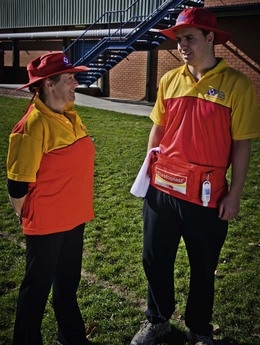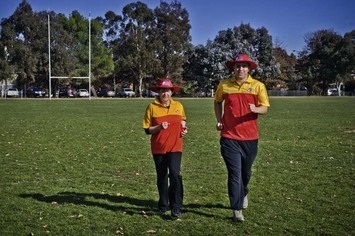Chapter One The sports trainer in action
1. Explain the operations expected of a sports trainer and the contexts in which they should be applied
2. Describe the accepted roles and responsibilities of a sports trainer
3. Demonstrate accepted safety and privacy practices
4. Detail ways of developing positive relationships with health care professionals
5. Demonstrate effective communication with athletes, coaches, parents and health care professionals
6. Detail professional development programs and options
7. Describe the components and processes necessary to establish a fair and equitable sporting environment
8. Demonstrate a range of emergency hand signals
9. Describe ethical and legal issues related to the activities of a sports trainer
10. Demonstrate effective communication skills between injured athletes and support staff
11. Demonstrate safe handling, maintenance and storage protocols of sports medicine equipment
12. Describe methods of accurately recording the details of an injured athlete
Introduction
 understand and operate within their scope of practice
understand and operate within their scope of practice
 adhere to accepted safety and privacy practices
adhere to accepted safety and privacy practices
 contribute to a safe, fair and equitable sporting environment
contribute to a safe, fair and equitable sporting environment
 communicate effectively with athletes, coaches, parents and health care professionals
communicate effectively with athletes, coaches, parents and health care professionals
 work collaboratively with, and refer appropriately to, health care professionals
work collaboratively with, and refer appropriately to, health care professionals
 appreciate ethical issues surrounding first aid and sports medicine
appreciate ethical issues surrounding first aid and sports medicine
 handle, maintain and store sports medicine equipment
handle, maintain and store sports medicine equipment
What is a sports trainer?
 implementing appropriate injury prevention protocols
implementing appropriate injury prevention protocols
 preparing players for competition
preparing players for competition
 providing the appropriate immediate management of injuries
providing the appropriate immediate management of injuries
 providing immediate crisis management of severe injuries
providing immediate crisis management of severe injuries
 informed referral of injuries to a more qualified health professional for further advice and management
informed referral of injuries to a more qualified health professional for further advice and management
 working in conjunction with health professionals, such as physiotherapists or doctors, to ensure a safe return to play for injured players
working in conjunction with health professionals, such as physiotherapists or doctors, to ensure a safe return to play for injured players
 educating players and coaching staff in relation to return to play principles.
educating players and coaching staff in relation to return to play principles.
Applying these skills improves the likelihood of a good outcome for anyone who has a sports-related injury or illness.
The requirements to achieve accreditation as an SMA Level 1 Sports Trainer include:
 having a current Apply First Aid Certificate, or equivalent
having a current Apply First Aid Certificate, or equivalent
 having a current Cardiopulmonary Resuscitation (CPR) Certificate
having a current Cardiopulmonary Resuscitation (CPR) Certificate
 completion of the SMA Safer Sport Program Level 1 Sports Trainer course, or equivalent.
completion of the SMA Safer Sport Program Level 1 Sports Trainer course, or equivalent.
 fulfilment of the accreditation criteria for a Level 1 Sports Trainer
fulfilment of the accreditation criteria for a Level 1 Sports Trainer
 completion of the SMA Safer Sport Program Level 2 Sports Trainer course, or equivalent.
completion of the SMA Safer Sport Program Level 2 Sports Trainer course, or equivalent.
Sports trainers and the law
Consent
1. Informed consent – sometimes also known as actual consent or express consent. For informed consent, the athlete or the parent/guardian specifically gives the sports trainer permission to help or render assistance. To gain a proper informed consent, it is necessary to explain to the athlete the likely benefits of the suggested treatment or intervention, as well as the possible risks and the alternative options available to them.
2. Implied consent – consent not actually granted by the person but implied from their actions or silence. It is based on what a reasonable person would usually expect to be done in the circumstances. For example, in an emergency situation, an unconscious athlete’s consent to assistance is implied.



















